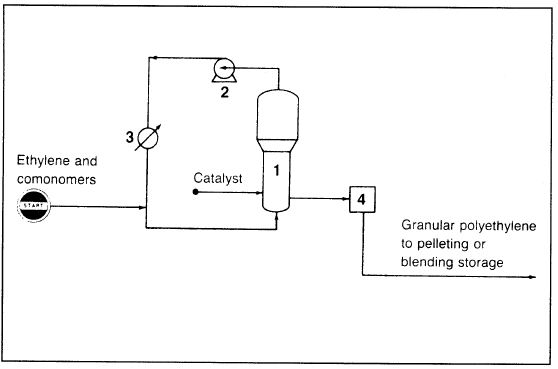


 علم الكيمياء
علم الكيمياء 
 الكيمياء التحليلية
الكيمياء التحليلية 
 الكيمياء الحياتية
الكيمياء الحياتية 
 الكيمياء العضوية
الكيمياء العضوية 
 الكيمياء الفيزيائية
الكيمياء الفيزيائية
 الكيمياء اللاعضوية
الكيمياء اللاعضوية 
 مواضيع اخرى في الكيمياء
مواضيع اخرى في الكيمياء
 الكيمياء الصناعية
الكيمياء الصناعية |
Read More
Date: 26-9-2017
Date: 20-9-2017
Date: 20-9-2017
|
High-Density Polyethylene
High-density polyethylene (HDPE) is produced by a low-pressure process in a fluid-bed reactor. Catalysts used for HDPE are either of the Zieglar-type (a complex of Al(C2H5)3 and α-TiCl4) or silicaalumina impregnated with a metal oxide such as chromium oxide or molybdenum oxide. Reaction conditions are generally mild, but they differ from one process to another. In the newer Unipol process (Figure 1.1) used to produce both HDPE and LLDPE, the reaction occurs in the gas phase.
Ethylene and the comonomers (propene, 1-butene, etc.) are fed to the reactor containing a fluidized bed of growing polymer particles. Operation temperature and pressure are approximately 100°C and 20 atmospheres. A single-stage centrifugal compressor circulates unreacted ethylene. The circulated gas fluidizes the bed and removes some of the exothermic reaction heat. The product from the reactor is mixed with additives and then pelletized. New modifications for gas-phase processes have been reviewed by Sinclair.
The polymerization of ethylene can also occur in a liquid-phase system where a hydrocarbon diluent is added. This requires a hydrocarbon recovery system. High-density polyethylene is characterized by a higher crystallinity and higher melting temperature than LDPE due to the absence of branching.

Figure 1.1. The Union Carbide Unipol process for producing HDPE: (1) reactor, (2) single-stage centrifugal compressor, (3) heat exchanger, (4) discharge tank.
Some branching could be incorporated in the backbone of the polymer by adding variable amounts of comonomers such as hexene. These comonomers modify the properties of HDPE for specific applications.



|
|
|
|
لصحة القلب والأمعاء.. 8 أطعمة لا غنى عنها
|
|
|
|
|
|
|
حل سحري لخلايا البيروفسكايت الشمسية.. يرفع كفاءتها إلى 26%
|
|
|
|
|
|
|
جامعة الكفيل تحتفي بذكرى ولادة الإمام محمد الجواد (عليه السلام)
|
|
|